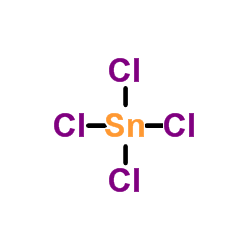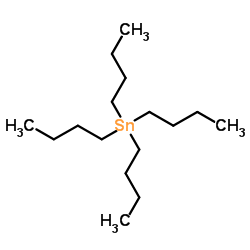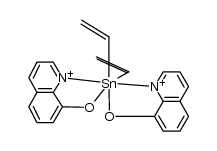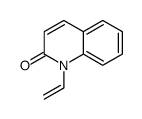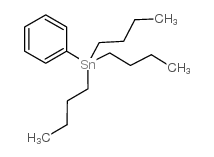1112-56-7
| 中文名 | 四乙烯基锡 |
|---|---|
| 英文名 | Tetravinyl tin |
| 英文别名 |
Stannane, tetraethenyl-
Stannane, tetravinyl- Tetravinylstannane MFCD00008608 tetrakis(ethenyl)stannane EINECS 214-193-6 TETRAVINYLTIN |
| 密度 | 1.246 g/mL at 25 °C(lit.) |
|---|---|
| 沸点 | 158.4±9.0 °C at 760 mmHg |
| 分子式 | C8H12Sn |
| 分子量 | 226.891 |
| 闪点 | 40.6±0.0 °C |
| 精确质量 | 227.996094 |
| LogP | 5.88 |
| 外观性状 | 透明无色至非常淡黄色液体 |
| 蒸汽压 | 3.4±0.3 mmHg at 25°C |
| 折射率 | n20/D 1.501(lit.) |
| 储存条件 | 密封储存,储存于阴凉、干燥的库房。远离火源,易燃易爆区。 |
| 稳定性 | 1.避免与不相容材料接触。 与强氧化剂反应。 2.对空气和湿气稳定。因该试剂分子中含有C-Sn 键而有剧毒,建议在通风橱中小心操作和使用。 |
| 分子结构 | 1、摩尔折射率:无可用的 2、摩尔体积(cm3/mol):无可用的 3、等张比容(90.2K):无可用的 4、表面张力(dyne/cm):无可用的 5、介电常数:无可用的 6、极化率(10-24cm3):无可用的 7、单一同位素质量:227.996099 Da 8、标称质量:228 Da 9、平均质量:226.8909 Da |
| 计算化学 | 1.疏水参数计算参考值(XlogP):无 2.氢键供体数量:0 3.氢键受体数量:0 4.可旋转化学键数量:4 5.互变异构体数量:无 6.拓扑分子极性表面积0 7.重原子数量:9 8.表面电荷:0 9.复杂度:107 10.同位素原子数量:0 11.确定原子立构中心数量:0 12.不确定原子立构中心数量:0 13.确定化学键立构中心数量:0 14.不确定化学键立构中心数量:0 15.共价键单元数量:1 |
| 更多 | 1. 性状:无色透明或浅黄色液体 2. 密度(g/mL,25℃):1.246 3. 相对蒸汽密度(g/mL,空气=1):未确定 4. 熔点(ºC):未确定 5. 沸点(ºC,常压):160-163 6. 沸点(ºC,1mmHg):未确定 7. 折射率(n20/D):1.501 8. 闪点(ºC):40 9. 比旋光度(º):未确定 10. 自燃点或引燃温度(ºC):未确定 11. 蒸气压(kPa,55ºC):未确定 12. 饱和蒸气压(kPa,25ºC):未确定 13. 燃烧热(KJ/mol):未确定 14. 临界温度(ºC):未确定 15. 临界压力(KPa):未确定 16. 油水(辛醇/水)分配系数的对数值:未确定 17. 爆炸上限(%,V/V):未确定 18. 爆炸下限(%,V/V):未确定 19. 溶解性:溶于大多数有机溶剂,通常在Et2O或者THF中使用。 |
Synonym:None Section 2 - COMPOSITION, INFORMATION ON INGREDIENTS
Risk Phrases: 10 23/24/25 Section 3 - HAZARDS IDENTIFICATION EMERGENCY OVERVIEW
Flammable. Toxic by inhalation, in contact with skin and if swallowed.The toxicological properties of this material have not been fully investigated. Potential Health Effects Eye: May cause eye irritation. The toxicological properties of this material have not been fully investigated. Skin: May cause skin irritation. The toxicological properties of this material have not been fully investigated. Ingestion: May cause gastrointestinal irritation with nausea, vomiting and diarrhea. The toxicological properties of this substance have not been fully investigated. Inhalation: May cause respiratory tract irritation. The toxicological properties of this substance have not been fully investigated. Vapors may cause dizziness or suffocation. Chronic: No information found. Section 4 - FIRST AID MEASURES Eyes: Flush eyes with plenty of water for at least 15 minutes, occasionally lifting the upper and lower eyelids. Get medical aid immediately. Skin: Get medical aid. Flush skin with plenty of water for at least 15 minutes while removing contaminated clothing and shoes. Wash clothing before reuse. Ingestion: If victim is conscious and alert, give 2-4 cupfuls of milk or water. Never give anything by mouth to an unconscious person. Get medical aid immediately. Inhalation: Remove from exposure and move to fresh air immediately. If not breathing, give artificial respiration. If breathing is difficult, give oxygen. Get medical aid. Notes to Physician: Section 5 - FIRE FIGHTING MEASURES General Information: As in any fire, wear a self-contained breathing apparatus in pressure-demand, MSHA/NIOSH (approved or equivalent), and full protective gear. Vapors may form an explosive mixture with air. During a fire, irritating and highly toxic gases may be generated by thermal decomposition or combustion. Will burn if involved in a fire. Use water spray to keep fire-exposed containers cool. Containers may explode in the heat of a fire. Flammable liquid and vapor. Vapors may be heavier than air. They can spread along the ground and collect in low or confined areas. Extinguishing Media: For small fires, use dry chemical, carbon dioxide, water spray or alcohol-resistant foam. For large fires, use water spray, fog, or alcohol-resistant foam. Use water spray to cool fire-exposed containers. Water may be ineffective. Do NOT use straight streams of water. Section 6 - ACCIDENTAL RELEASE MEASURES General Information: Use proper personal protective equipment as indicated in Section 8. Spills/Leaks: Absorb spill with inert material (e.g. vermiculite, sand or earth), then place in suitable container. Clean up spills immediately, observing precautions in the Protective Equipment section. Remove all sources of ignition. Use a spark-proof tool. Provide ventilation. A vapor suppressing foam may be used to reduce vapors. Section 7 - HANDLING and STORAGE Handling: Wash thoroughly after handling. Use with adequate ventilation. Ground and bond containers when transferring material. Use spark-proof tools and explosion proof equipment. Avoid contact with eyes, skin, and clothing. Empty containers retain product residue, (liquid and/or vapor), and can be dangerous. Keep container tightly closed. Keep away from heat, sparks and flame. Avoid ingestion and inhalation. Do not pressurize, cut, weld, braze, solder, drill, grind, or expose empty containers to heat, sparks or open flames. Storage: Keep away from heat, sparks, and flame. Keep away from sources of ignition. Store in a tightly closed container. Store in a cool, dry, well-ventilated area away from incompatible substances. Flammables-area. Section 8 - EXPOSURE CONTROLS, PERSONAL PROTECTION Engineering Controls: Use adequate ventilation to keep airborne concentrations low. Exposure Limits CAS# 1112-56-7: United Kingdom, WEL - TWA: (listed as tin organic compounds): 0.1 mg/m3 TWA (except cyhexatin, as Sn) United Kingdom, WEL - STEL: (listed as tin organic compounds): 0. mg/m3 STEL (except cyhexatin, as Sn) United States OSHA: 0.1 mg/m3 TWA (as Sn) (listed under Tin orga compounds). Belgium - TWA: (listed as tin organic compounds): 0.1 mg/m3 VLE ( Sn) Belgium - STEL: (listed as tin organic compounds): 0.2 mg/m3 VLE Sn) France - VME: (listed as tin organic compounds): 0.1 mg/m3 VME (a Sn) France - VLE: (listed as tin organic compounds): 0.2 mg/m3 VLE (a Sn) Germany: (listed as tin organic compounds): 0.1 mg/m3 VME (as Sn) Germany: (listed as tin organic compounds): Skin absorber Malaysia: (listed as tin organic compounds): 0.1 mg/m3 TWA (as Sn Netherlands: (listed as tin organic compounds): 0.2 mg/m3 STEL (a Sn) Netherlands: (listed as tin organic compounds): 0.1 mg/m3 MAC (as Spain: (listed as tin organic compounds): 0.1 mg/m3 VLA-ED (as Sn Spain: (listed as tin organic compounds): 0.2 mg/m3 VLA-EC (as Sn Personal Protective Equipment Eyes: Wear appropriate protective eyeglasses or chemical safety goggles as described by OSHA's eye and face protection regulations in 29 CFR 1910.133 or European Standard EN166. Skin: Wear appropriate protective gloves to prevent skin exposure. Clothing: Wear appropriate protective clothing to prevent skin exposure. Respirators: Follow the OSHA respirator regulations found in 29 CFR 1910.134 or European Standard EN 149. Use a NIOSH/MSHA or European Standard EN 149 approved respirator if exposure limits are exceeded or if irritation or other symptoms are experienced. Section 9 - PHYSICAL AND CHEMICAL PROPERTIES Physical State: Liquid Color: clear, colorless Odor: Not available. pH: Not available. Vapor Pressure: Not available. Viscosity: Not available. Boiling Point: 160 - 163 deg C Freezing/Melting Point: Not available. Autoignition Temperature: Not available. Flash Point: 40 deg C ( 104.00 deg F) Explosion Limits, lower: N/A Explosion Limits, upper: N/A Decomposition Temperature: Solubility in water: Specific Gravity/Density: 1.2460g/cm3 Molecular Formula: Sn(CH=CH2)4 Molecular Weight: 226.88 Section 10 - STABILITY AND REACTIVITY Chemical Stability: Stable at room temperature in closed containers under normal storage and handling conditions. Conditions to Avoid: Incompatible materials, ignition sources, excess heat. Incompatibilities with Other Materials: Oxidizing agents. Hazardous Decomposition Products: Carbon monoxide, irritating and toxic fumes and gases, carbon dioxide. Hazardous Polymerization: Has not been reported Section 11 - TOXICOLOGICAL INFORMATION RTECS#: CAS# 1112-56-7 unlisted. LD50/LC50: Not available. Carcinogenicity: Tetravinyl Tin - Not listed by ACGIH, IARC, or NTP. Section 12 - ECOLOGICAL INFORMATION Section 13 - DISPOSAL CONSIDERATIONS Dispose of in a manner consistent with federal, state, and local regulations. Section 14 - TRANSPORT INFORMATION IATA Shipping Name: FLAMMABLE LIQUID, TOXIC, N.O.S.* Hazard Class: 3 (6.1) UN Number: 1992 Packing Group: III IMO Shipping Name: FLAMMABLE LIQUID, TOXIC, N.O.S. Hazard Class: 3.3 (6.1) UN Number: 1992 Packing Group: III RID/ADR Shipping Name: FLAMMABLE LIQUID, TOXIC, N.O.S. Hazard Class: 3 (6.1) UN Number: 1992 Packing group: III Section 15 - REGULATORY INFORMATION European/International Regulations European Labeling in Accordance with EC Directives Hazard Symbols: T Risk Phrases: R 10 Flammable. R 23/24/25 Toxic by inhalation, in contact with skin and if swallowed. Safety Phrases: S 9 Keep container in a well-ventilated place. S 16 Keep away from sources of ignition - No smoking. S 28A After contact with skin, wash immediately with plenty of water. S 33 Take precautionary measures against static discharges. S 36/37/39 Wear suitable protective clothing, gloves and eye/face protection. S 37 Wear suitable gloves. S 45 In case of accident or if you feel unwell, seek medical advice immediately (show the label where possible). WGK (Water Danger/Protection) CAS# 1112-56-7: No information available. Canada None of the chemicals in this product are listed on the DSL/NDSL list. CAS# 1112-56-7 is not listed on Canada's Ingredient Disclosure List. US FEDERAL TSCA CAS# 1112-56-7 is not listed on the TSCA inventory. It is for research and development use only. SECTION 16 - ADDITIONAL INFORMATION N/A |
| 符号 |


GHS02, GHS06 |
|---|---|
| 信号词 | Danger |
| 危害声明 | H226-H301-H311-H331 |
| 警示性声明 | P261-P280-P301 + P310-P311 |
| 个人防护装备 | Eyeshields;Faceshields;full-face respirator (US);Gloves;multi-purpose combination respirator cartridge (US);type ABEK (EN14387) respirator filter |
| 危害码 (欧洲) | T: Toxic; |
| 风险声明 (欧洲) | R10;R23/24/25 |
| 安全声明 (欧洲) | S36/37/39-S45 |
| 危险品运输编码 | UN 1993 3/PG 3 |
| WGK德国 | 3 |
| 包装等级 | II |
| 危险类别 | 6.1(a) |
| 海关编码 | 2931900090 |
|
~73% 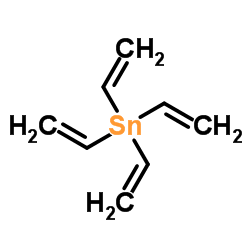
1112-56-7 |
| 文献:Sn: Org.Verb.1, 1.1.1.14.1, page 129 - 133 |
|
~83% 
1112-56-7 |
| 文献:US2873287 , ; C.A., , p. 13108 US2965661 , ; C.A., , p. 6377 GB829243 , ; C.A., , p. 21139 |
|
~% 
1112-56-7 |
| 文献:Journal of the American Chemical Society, , vol. 79, p. 2137 |
|
~% 
1112-56-7 |
| 文献:Journal of the American Chemical Society, , vol. 79, p. 515 |
|
~% 
1112-56-7 |
| 文献:Journal of Organometallic Chemistry, , vol. 694, # 15 p. 2368 - 2374 |
|
~% 
1112-56-7 |
| 文献:Journal of Organometallic Chemistry, , vol. 277, # 2 p. 235 - 244 |
|
~% 
1112-56-7 |
| 文献:Sn: Org.Verb.1, 1.1.1.5.4.5, page 106 - 108 |
|
~% 
1112-56-7 |
| 文献:Sn: Org.Verb.1, 1.1.1.16.1.4.5, page 159 - 161 |
|
~% 
1112-56-7 |
| 文献:Inorganica Chimica Acta, , vol. 150, p. 287 - 292 |
| 上游产品 9 | |
|---|---|
| 下游产品 10 | |
| 海关编码 | 2931900090 |
|---|---|
| 中文概述 | 2931900090. 其他有机-无机化合物. 增值税率:17.0%. 退税率:13.0%. 监管条件:AB(入境货物通关单,出境货物通关单). 最惠国关税:6.5%. 普通关税:30.0% |
| Summary | 2931900090. other organo-inorganic compounds. VAT:17.0%. Tax rebate rate:13.0%. Supervision conditions:AB(certificate of inspection for goods inward,certificate of inspection for goods outward). MFN tariff:6.5%. General tariff:30.0% |







